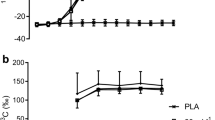Summary
The distribution of substrates utilized during prolonged exercise was investigated in normal human volunteers with and without ingestion of 100 g exogenous glucose. The energy provided by protein oxidation was derived from urinary nitrogen excretion and the total energy provided by carbohydrates and lipids was calculated from respiratory quotient (RQ) determinations. The contribution of exogenous glucose to the energy supply was determined by an original procedure using “naturally labeled 13C-glucose” as metabolic tracer. Protein oxidation provided between 1 and 2% of the total energy requirement; this amount was not affected by glucose ingestion. In the absence of exogenous glucose ingestion, carbohydrate were progressively replaced by lipids as source of energy. Exogenous glucose contributed markedly to total carbohydrate oxidation and decreased the percentage of energy derived from lipids. In addition, ingestion of exogenous glucose resulted in a significant economy of endogenous carbohydrates and permitted to prolong the duration of exercise.
Similar content being viewed by others
References
Ahlborg, G., Felig, P., Hagenfeldt, L.: Substrate turnover during prolonged exercise in man: splanchnic and leg metabolism of glucose free fatty acids, and amino acids. J. clin. Invest. 53, 1080–1090 (1974)
Benade, A. J. S., Jansen, C. R., Rogers, G. G., Wyndham, C. H., Strydom, N. B.: The significance of an increased RQ after sucrose ingestion during prolonged aerobic exercise. Pflügers Arch. 342, 199–206 (1973)
Bergström, J., Hermansen, L., Hultman, E., Saltin, B.: Diet, muscle glycogen and physical performance. Acta physiol. scand. 71, 140–150 (1967)
Carlson, L. A., Pernow, B.: Studies of blood lipids during exercise. Arterial and venous plasma concentration of unesterified fatty acid. J. Lab. clin. Med. 53, 833–841 (1959)
Christensen, E. H., Hansen, O.: ArbeitsfÄhigkeit und ErnÄhrung. Skand. Arch. Physiol. 81, 160–172 (1939)
Costill, D. L., Bowers, R., Sparks, K., Turner, C.: Muscle glycogen utilization during prolonged running. J. appl. Physiol. 31, 353–356 (1971)
Costill, D. L., Benett, A., Branam, G., Eddy, D.: Glucose ingestion at rest and during prolonged exercise. J. appl. Physiol. 34, 764–769 (1973)
Dill, D. B., Edwards, H. T., Talbott, J. H.: Studies in muscular activity. VII. Factors limiting the capacity of work. J. Physiol. 77, 49–54 (1932)
Duchesne, J., Mosora, F., Lacroix, M., Lefebvre, P., Luyckx, A., Lopez-Habib, G.: Une application clinique d'une nouvelle méthode biophysique basée sur l'analyse isotopique du CO2 exhalé par l'homme. C.R. Acad. Sci. (Paris) 277D, 2261–2264 (1973)
Friedberg, S. J., Harlan, W. R., Jr., Trout, D. L., Estes, E. H., Jr.: The effect of exercise on the concentration and turnover of plasma nonesterified fatty acids. J. clin. Invest. 39, 215–230 (1960)
Hoffman, W. S.: A rapid photoelectric method for the determination of glucose in blood and urine. J. biol. Chem. 120, 51–55 (1937)
Hultman, E., Bergström, J.: Muscle glycogen synthesis in relation to diet studied in normal subjects. Acta med. scand. 182, 109–117 (1967)
Hultman, E., Bergström, J., Roch-Norlund, A. E.: Glycogen storage in human skeletal muscle. In: Muscle metabolism during exercise (B. Pernow, B. Saltin, ed.), pp. 273–288. New-York: Plenum 1971
Issekutz, B., Jr., Miller, H. I., Rodahl, K.: Lipid and carbohydrate metabolism during exercise. Fed. Proc. 25, 1415–1420 (1966)
Issekutz, B., Jr., Miller, H. I., Paul, P., Rodahl, K.: Aerobic work capacity and plasma FFA turnover. J. appl. Physiol. 20, 293–296 (1965)
Keul, J., Doll, E., Kepler, D.: Energy metabolism of human muscle. Basel: Karger 1972
Lacroix, M., Mosora, F., Pontus, M., Lefebvre, P., Luyckx, A., Lopez-Habib, G.: Glucose naturally labeled with carbon-13: use for metabolic studies in man. Science 181, 445–446 (1973)
Lacroix, M., Mosora, F.: Variations du rapport 13C/12C dans le métabolisme animal. A congress report, in isotope ratios as pollutant source and behaviour indicators. At. En. Ag. Vienna 343–358 (1975)
Lusk, G.: The science of nutrition. Philadelphia: Saunders 1928
Metropolitan Life Insurance Company: Statistical Bulletin, (tables 2 and 3). 40 (1959)
Mosora, F., Lacroix, M., Pontus, M., Duchesne, J.: Effets de la désoxycorticostérone, du glucagon et de l'insuline sur le rapport isotopique 13C/12C du CO2 respiratoire chez le rat. Bull. Acad. roy. Belg. Sci. 58, 565–576 (1972)
Mosora, F., Lefebvre, P., Pirnay, F., Lacroix, M., Luyckx, A., Duchesne, J.: Quantitative evaluation of the oxidation of an exogenous glucose load using naturally labeled 13C-glucose. Metabolism 25, 1575–1582 (1976)
Paul, P.: FFA metabolism of normal dogs during steady-state exercise at different work loads. J. appl. Physiol. 28, 127–132 (1970)
Paul, P.: Effects of long lasting physical exercise and training on lipid metabolism. In: Metabolic adaptation to prolonged physical exercise (H. Howald, J. R. Poortmans, ed.), pp. 156–193. Basel: BirkhÄuser 1975
Pirnay, F., Lacroix, M., Mosora, F., Luyckx, A., Lefebvre, P.: Glucose oxidation during prolonged exercise evaluated with naturally labeled 13C-glucose. J. appl. Physiol. (in press)
Shreeve, W. W.: Potential uses of 13C-labeled carbohydrates in the study and diagnosis of diabetes mellitus. Proceed 1st Int. Conf. Stable Isotopes, May, 1973, Argonne, III., USAEC Conf. 730525
Smith, B., Epstein, S.: Two categories of 13C/12C ratios for higher plants. Plant Physiol. 47, 380–384 (1971)
Wahren, J., Felig, P., Ahlborg, G., Jorfeldt, L.: Glucose metabolism during leg exercise in man. J. clin. Invest. 50, 2715–2725 (1971)
Wahren, J. P., Felig, P., Hagenfeldt, L., Hendler, R., Ahlborg, G.: Splanchnic and leg metabolism of glucose, free fatty acids and amino acids during prolonged exercise in man. In: Metabolic adaptation to prolonged physical exercise (H. Howald, J. R. Poortmans, ed.), pp. 144–153. Basel: BirkhÄuser 1975
Wilkerson, H. L. C.: Diagnosis, oral glucose tolerance tests. In: Diabetes mellitus: Diagnosis and treatment, pp. 31–34. New York: American Diabetes Association 1964
Young, D. R., Pelligra, R., Shapira, J., Adachi, R. R., Skrettin-Gland, K.: Glucose oxidation and replacement during prolonged exercise in man. J. appl. Physiol. 23, 734–741 (1967)
Author information
Authors and Affiliations
Rights and permissions
About this article
Cite this article
Pirnay, F., Lacroix, M., Mosora, F. et al. Effect of glucose ingestion on energy substrate utilization during prolonged muscular exercise. Europ. J. Appl. Physiol. 36, 247–254 (1977). https://doi.org/10.1007/BF00423050
Received:
Issue Date:
DOI: https://doi.org/10.1007/BF00423050




